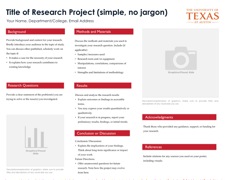General specifications
Size: An A1 sheet (equivalent to four A3 sheets).
Orientation: Portrait preferred.
Lamination: It’s a good idea to get your poster laminated.
Font size: Large enough to be easily read from 1 to 1.5 metres away e.g., 24 point for
main text.
Suggested content
Research / Project Title: Approximately 25 mm tall (point 96).
Additional identifying information: Approximately 19 to 25 mm (e.g., point 80). May
also be on an additional label / strip above the main poster.
- Name of Organization(s) / Programme / Affiliation
- Researcher(s) Name
Problem Outline & Aims: Bulleted information describing the research issues and
objectives.
Summary of Methods: Bulleted information describing how the research was
conducted and any challenges encountered.
Illustrations: Photographs, graphs, graphics, or other "art" that illustrate the research
project. Graphic information is easier to process quickly than text information. Look for
imaginative ways to graphically explain your project and its impact.
Results & Conclusions: Bulleted information describing your findings and discussing
the conclusions of the research programme or project.
Acknowledgements & References: At the end of the poster.
Additional information: Any additional information that you think would enhance the
presentation.
General Advice
A research poster is very different from a paper or a talk, and to produce one requires
different techniques. Simplicity is essential in a poster – it should tell a story. As in any
research presentation, the outline includes a statement of the problem, a description of
the method, a summary of the work, and then a presentation of results. But within that
structure, there is much scope for creativity. A question-and-answer (Q&A) format, for
example, may be appropriate for part of your poster. Brief conclusions should leave the
reader with a clear message to take away
A typical reader may spend only 5 minutes looking at your poster, so there should be
less clutter and more brief informative statements, with attractive, enlightening graphics.
It should not contain a lot of details—you can always explain the fine points to interested
participants. Keep in mind that your poster will be one among others in the exhibition
area: it needs to capture and hold the reader’s attention.
Further advice on designing effective posters is available in various books and website
articles – for instance, Pennsylvania State University’s guide is a good place to start,
and has links to other resources.
Transporting a poster may be awkward, but rolling the paper into a cylinder is one way
around this. As suggested above, you may wish to have A4 sized photocopies of the
poster as a handout. Alternatively, if the work presented in the poster has been
described in more detail in a paper, consider making the paper (or any associated
presentation slides) available as a handout at the poster session.
References:















